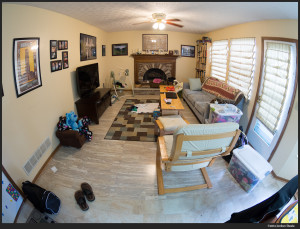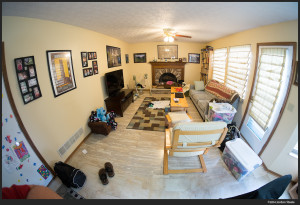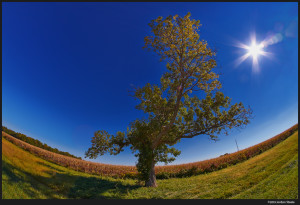Image Quality
Fisheye Projection

I’m going to get a little technical for a minute here to discuss something unique with this lens. The Rokinon 8mm f/2.8 Fisheye is unique in that it features a unique projection compared to what almost all other manufacturers use with their fisheye lenses.
Fisheyes can have several different projections…that is how it maps a point of light in space to the image sensor. A non-fisheye lens can be said to have a rectilinear projection. This keep lines straight throughout the image, but in wide-angle lenses, this results in the size of objects at the images edges being stretched larger than they are in real life. It also distorts circular objects into ovals.
All fisheye lenses distort straight lines into curves (unless the line passes through the image center). However, most fisheye lenses use either an equisolid angle projection or an equidistant projection. Both of these projections are similar in look, but result in that classic extreme bulge in the center, with the elements towards the edges of the frames becoming a bit more compressed. These can still be 180 degrees across the diagonal, and you still get a very wide horizontal and vertical field of view.

However, the Rokinon (Samyang) 8mm f/2.8 for mirrorless cameras uses a projection that is essentially stereographic. This projection maintains the proper relation of angles in an image. The result is a fisheye that has a less pronounced center bulge, no edge size compression and a slightly wider horizontal and vertical field of view for the same diagonal field of view. In practical terms, the Rokinon 8mm fisheye is slightly wider (horizontally and vertically) than most other fisheyes, and provides a more natural looking image. Take a look at the two images to the right (excuse the clutter). These are the same scene from the same spot with the Panasonic 8mm fisheye on the OM-D E-M5 and the Rokinon 8mm fisheye on the X-E1. You can see the different look the Rokinon fisheye gives you, as well as the notably wider horizontal field of view. Part of this is from the Fuji’s 3:2 aspect ratio, vs the 4:3 aspect ratio of the OM-D, but most of the difference is from the different projection. You can see that even though the OM-D shot has a vertical field of view advantage due to aspect ratio, the Rokinon shot still has a wider vertical field of view as well. I’ve always liked fisheyes, but the stereographic projection used by this lens is a big plus.
Sharpness

The Rokinon 8mm is generally quite a sharp lens. At f/2.8, the central region is sharp, though the edges and corners are a bit soft. Stopped down to f/8 or so, the lens maintains good image sharpness all the way to the corners. As I mentioned earlier, my lens is slightly softer on the right edge, but you really need to pixel peep in order to see it.
Bokeh
Bokeh? What bokeh? The one big downside to the Rokinon 8mm fisheye is it does have a rather long minimum focus distance for a fisheye lens. The 8mm is only able to focus down to 0.3m, which is actually further away than the Fuji 23mm f/1.4. With the extreme field of view, this is not particularly close. As a result, throwing backgrounds out of focus isn’t really easy to do. There are some out of focus areas when focused very closely, and the bokeh is unobjectionable, but it’s hard to characterize due to the minimum of actual blur present.
Color, Contrast and Chromatic Aberration
The Rokinon 8mm is a rather contrasty lens, providing plenty of image pop throughout. The color rendering is relatively neutral…nothing special to note here. There is a small amount of lateral chromatic aberration, which can be seen as a magenta or cyan edge near the image corners and edges, though it’s relatively well controlled and easily corrected in RAW development.
Distortion, Flare and Vignetting

The Rokinon 8mm fisheye appears to exhibit some barrel distortion. Ok – just checking to make sure you’re reading. Of course, given its fisheye nature, the 8mm produces heavy fisheye type distortion, causing all straight lines except those in the center to curve. I’ve already covered the type of distortions given by this particular fisheye in the discussion on projection above.
The lens is generally resistant to flare in most instances, which is good, since there will be light sources in your images in many circumstances given the wide field of view. However, it’s not among the best performing fisheyes I’ve seen in this department. If the sun is placed near a corner, there can be some wild flare artifacts produced. Of all the fisheyes I’ve used and owned (which total five), the Sigma 15mm fisheye for full frame cameras had the best flare control – it was nearly impossible to get that lens to flare. The Rokinon is merely OK here. See the image to the left to see what amounts to the worst case scenario for flare. Vignetting, however, is not really a problem for this lens.





Leave a Reply